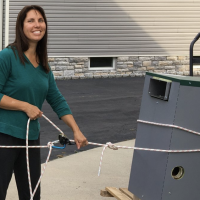deleting unused steam riser
I have 3 family building that I'm renovating. 2nd and 3rd floor are finished. There's a steam riser teeing off on each floor to a radiator connection. On the 2nd and 3rd floor the radiator has been deleted due to layout. (Both areas were turned into laundry closets).
One the first floor, the layout could use a radiator in said location. So the riser after the tee on the first floor is useless. I'd like to remove it so I don't have to pad out the wall to hide it. It would gain me a few inches - which is valuable space in Brooklyn.
I can remove the 90el and cap it. (See picture below). At that point, I could rig up support with a riser clamp and some 2x in the 2nd floors joist bay (also the 1st floors ceiling). Then I could abandon the riser and tees on the 2nd and 3rd floors.
Is this a good solution?
(The building is insulated with closed cell spray foam and I'm using mini splits as the primary heat source. Steam rads are being used as backup).
Comments
-
-
Oh that's a good point. The pipe i'm keeping is probably getting rigidity from the riser.
0 -
I would crack the cast fittings that is being capped before cutting . You would need two hammers . Use lug hammer ( hand held sledge) to hold against the fitting while hitting the other side with another hammer . The hammer held directs the force to the fitting . You will hear a different tone when the cast fitting cracks ,then spin it off . You don't want to beat it to death to remove the fitting , you could damage the threads
Hope this helps …
There was an error rendering this rich post.
2 -
Not sure I have room to place a backup hammer anywhere. Maybe I can put some scrap metal behind that 90 el.
Slightly off topic - what size cape chisel do you guys recommend to collapse the 1 1/4 pipe going into that 90 el? Amazon sells them in sizes from 1/8" all the way to 1/2".
0 -
If close to a beam , yes that chisel would work fine jamming between .. Cast is brittle as glass , all it takes is a little movement to crack.. You want the fitting to get most of the force..
Take a car at a light with its brakes on and the driver notices a car behind that is not going to stop . If the driver stays on the breaks and the second hits, the first car gets most of the damage . If the driver releases the brake , the second car gets most of the damage .. This is how it was explained to me ..
Once you hear the change of hammer tone , then use a wrench . You want to protect the threads ..
There was an error rendering this rich post.
0 -
How is that riser vented? Unless that riser is close to the main in the basement, you will need to move the vent from the top of the current riser to wherever you cut it off.
0 -
@branimal the 5/16 is probably right.
I just take an old cold chisel from a tag sale and grind it on an angle works just as good. Dip it in water and don't overheat it.
0 -
-
I think diablo makes oscillating saw blades in that same material as the reciprocating saw blades that work well on ci and steel.
0
Categories
- All Categories
- 87.3K THE MAIN WALL
- 3.2K A-C, Heat Pumps & Refrigeration
- 61 Biomass
- 429 Carbon Monoxide Awareness
- 120 Chimneys & Flues
- 2.1K Domestic Hot Water
- 5.8K Gas Heating
- 114 Geothermal
- 166 Indoor-Air Quality
- 3.7K Oil Heating
- 77 Pipe Deterioration
- 1K Plumbing
- 6.5K Radiant Heating
- 395 Solar
- 15.7K Strictly Steam
- 3.4K Thermostats and Controls
- 56 Water Quality
- 51 Industry Classes
- 50 Job Opportunities
- 18 Recall Announcements






